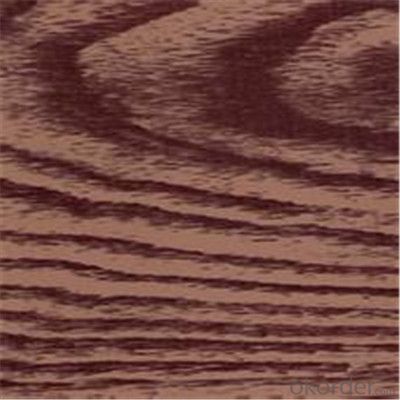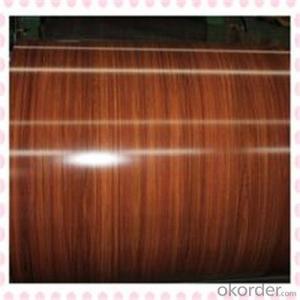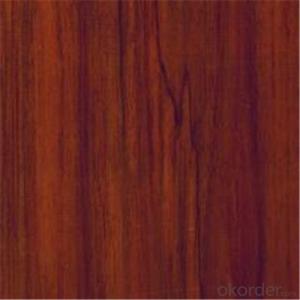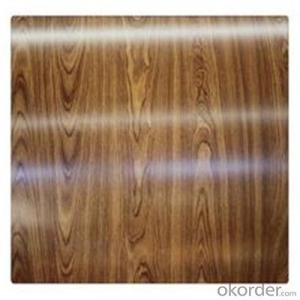Wooden Grain Printing Galvanized PPGI Steel Sheets
- Loading Port:
- Tianjin
- Payment Terms:
- TT OR LC
- Min Order Qty:
- 22 m.t.
- Supply Capability:
- 1200000 m.t./month
OKorder Service Pledge
OKorder Financial Service
You Might Also Like
Item specifice
Description of PPGI:
1. Thickness: 0.25-1.2mm
2. Width: 914*1250mm
3. Inner Diameter: 508mm
4. Weight of Steel Coil: 4-10MT
5. Available Dipped zinc : 50-275g/m2
6. Surface Texture: Normal Coated
7. Type of coating structure: 2/1 Coat the top surface of the steel sheet twice,
coat the bottom surface once, and bake the sheet twice.
8. Front side paint thickness: 15-25μm (bottome paint + top paint)
9. Back side paint thickness: 5-10μm
Festures of PPGI:
Building industry | Outdoor application | Roof, structural balcony, panels, window sills, window frames, gates, garage doors |
Indoor application | Room doors, dividing walls, door frames, light house steel structures, sliding doors |
Specifications of PPGI:
1) Steel buildings and constructions: roofing, ceilings, gutters, venting lines, indoor decorations, doors,window frames etc.
2) Electrical appliances: computer shells, washing machines, refrigerators, dehumidifiers, video recorders, water heaters etc.
3) Agricultural equipments: troughs, feeding tools, agricultural driers, irrigation channels etc.
4) Vehicle parts: back-seat plates of buses and trucks, conveying systems, oil tanks etc.
Images of PPGI:

FAQ:
1.What about the delivery.
We can arrange the shipment about 15-25 days after the deposit.
2.What about payment term?
30% T/T deposit, balance against B/L copy.
Full T/T payment if quantity less than MOQ.
3.How much about MOQ?
Normally 100pcs,but small order is acceptable as well.
- Q:How are steel coils used in the manufacturing of solar panels?
- Steel coils are used in the manufacturing of solar panels primarily for the structural support and durability they provide. These coils are often used to construct the frames and mounting systems that hold the solar panels in place. The strength of steel ensures that the panels remain stable and secure, even in harsh weather conditions. Additionally, steel coils can be shaped and formed to meet the specific design requirements of solar panel installations, making them a crucial component in the manufacturing process.
- Q:In pounds per square inch what is the tensile strength of strong steel?
- It is refereed to the ultimate tensile strength which is the point at which the specimen of steel fail (rapture) when subjected to a force,measured by unit force divided by cross section of steel.
- Q:What are the different types of steel grades used for coil production?
- There are several types of steel grades used for coil production, including carbon steel, stainless steel, and alloy steel. Carbon steel is the most common type and is widely used due to its affordability and versatility. Stainless steel is highly resistant to corrosion and is often used in applications where hygiene and appearance are important. Alloy steel, on the other hand, contains additional elements such as manganese, nickel, and chromium, which enhance its strength and durability. Each type of steel grade has its own unique properties and is chosen based on the specific requirements of the coil production process.
- Q:Steel sticks- it has meaning to us -similar to my deceased father's name, Steven fits our style as people. We like the hardness of it for our little man. We need a middle name though. Open to suggestions, thank you=)
- Steel ___ Tompkins xavier jax stone blaise/blaze navarro dialo zorion soloman eron muron darko vincent wolf giovanni ryker/rykeir orvall oryan/orian isadore reese axel/axl xander/zander zane zeke dane xan/zan grayson griffin trayton urban sterling - probably wouldn't sound good with steel but its another choice you can have STOP HATING SHE SAID SHE DIDNT LIKE COMMON NAMES!
- Q:What are the common processing defects in steel coils?
- Steel manufacturers must identify and rectify the following processing defects commonly found in steel coils: 1. Coil breaks: These occur when the steel strip breaks during the process of winding the coil. Improper tension control or material defects can cause these breaks. 2. Slivers: Thin, elongated steel pieces get trapped in the coil during the rolling process. Foreign materials, scale, or defects in the rolling mill can cause slivers. 3. Edge cracks: Cracks appearing along the edges of the coil are known as edge cracks. Improper edge trimming, material defects, or excessive rolling forces can cause these cracks. 4. Surface defects: Scratches, pits, or scars on the steel coil constitute surface defects. Handling issues, improper cleaning, or rolling mill defects can cause such defects. 5. Coil set: Coil set refers to the coil's tendency to retain a curvature even after it has been uncoiled. This can occur due to uneven cooling during the rolling process or improper tension control. 6. Oil spots: Stains or discolorations on the steel coil caused by residual oil or lubricants are known as oil spots. Inadequate cleaning or incorrect lubricant application can lead to oil spots. 7. Wavy edges: Irregularities or waves along the edges of the steel coil are referred to as wavy edges. Uneven rolling forces or improper edge trimming can cause these irregularities. 8. Lamination: Lamination defects occur when layers or sheets of steel are not properly bonded together. Material defects or improper rolling conditions can cause lamination defects. 9. Burr: A raised edge or roughness along the edge of the steel coil is called a burr. Improper trimming or cutting processes can cause burrs. 10. Non-uniform thickness: Non-uniform thickness refers to variations in the thickness of the steel coil. Uneven rolling forces, improper cooling, or material defects can cause non-uniform thickness. Identifying and addressing these processing defects is crucial for steel manufacturers to ensure the quality and reliability of their steel coils.
- Q:What are the different types of steel coil finishing processes?
- There are several different types of steel coil finishing processes that are used to enhance the appearance and properties of the steel coils. Some of the common types include: 1. Hot-dip galvanizing: This process involves immersing the steel coil in a bath of molten zinc, which creates a protective layer on the surface of the coil. This not only enhances the corrosion resistance of the steel but also provides a smooth and visually appealing finish. 2. Cold rolling: Cold rolling is a process in which the steel coil is passed through a series of rollers at room temperature to reduce its thickness and improve its surface finish. This process can impart a variety of finishes, ranging from a matte to a highly polished surface. 3. Electro-galvanizing: In this process, a thin layer of zinc is applied to the surface of the steel coil through an electrolytic deposition. Electro-galvanizing is commonly used for applications that require a thinner zinc coating and a more uniform finish. 4. Pickling and oiling: Pickling involves treating the steel coil with an acid solution to remove any scale or surface impurities, resulting in a clean and smooth surface. After pickling, the coil is usually coated with oil to prevent rusting during storage and transportation. 5. Powder coating: Powder coating is a popular finishing process that involves applying a dry powder to the steel coil and then curing it under heat to form a durable and attractive finish. This method allows for a wide range of colors and finishes to be applied to the steel. 6. Paint coating: Similar to powder coating, paint coating involves applying a liquid paint to the surface of the steel coil. This process can provide a decorative finish while also offering protection against corrosion and other environmental factors. These are just a few examples of the different types of steel coil finishing processes. The choice of the finishing method depends on the specific requirements of the application, such as the desired appearance, corrosion resistance, and durability.
- Q:What are the main factors that affect the corrosion resistance of steel coils?
- The main factors that affect the corrosion resistance of steel coils include the composition and purity of the steel, the presence of alloying elements, the surface condition and finish of the coils, the exposure to moisture and corrosive substances, and the protective coatings or treatments applied to the steel.
- Q:Can steel coils be coated with weather-resistant materials?
- Yes, steel coils can be coated with weather-resistant materials. Coating steel coils with weather-resistant materials helps to protect them from corrosion and other weather-related damages, extending their lifespan and ensuring their durability in various weather conditions.
- Q:Can steel coils be stored in a humid environment?
- Steel coils can be stored in a humid environment, but it is not ideal. Humidity can cause steel coils to rust and corrode, leading to potential damage or degradation of the steel. It is recommended to store steel coils in a dry and well-ventilated area to protect them from the negative effects of humidity.
- Q:What are the common coil edge finishes?
- The common coil edge finishes include slit edge, mill edge, and deburred edge.
1. Manufacturer Overview |
|
|---|---|
| Location | |
| Year Established | |
| Annual Output Value | |
| Main Markets | |
| Company Certifications | |
2. Manufacturer Certificates |
|
|---|---|
| a) Certification Name | |
| Range | |
| Reference | |
| Validity Period | |
3. Manufacturer Capability |
|
|---|---|
| a)Trade Capacity | |
| Nearest Port | |
| Export Percentage | |
| No.of Employees in Trade Department | |
| Language Spoken: | |
| b)Factory Information | |
| Factory Size: | |
| No. of Production Lines | |
| Contract Manufacturing | |
| Product Price Range | |
Send your message to us
Wooden Grain Printing Galvanized PPGI Steel Sheets
- Loading Port:
- Tianjin
- Payment Terms:
- TT OR LC
- Min Order Qty:
- 22 m.t.
- Supply Capability:
- 1200000 m.t./month
OKorder Service Pledge
OKorder Financial Service
Similar products
New products
Hot products
Related keywords





























